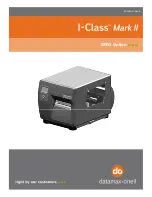
Rev. 3.02
- 7 -
SRP-350
1-3 Precaution for Electrostatically Sensitive Devices (ESDs)
1. Some semiconductor (solid state) devices are easily damaged by static electricity. Such components are
called Electrostatically Sensitive Devices (ESDs); examples include integrated circuits and some field-
effect transistors. The following techniques will reduce the occurrence of component damaged caused by
static electricity.
2. Immediately before handling any semiconductor components or assemblies, drain the electrostatic charge
from your body by touching a known earth ground. Alternatively, wear a discharging wrist-strap device.
(Be sure to remove it prior to applying power-this is an Electric shock precaution.)
3. After removing an ESD-equipped assembly, place it on a conductive surface such as aluminum foil to
prevent accumulation of electrostatic charge.
4. Do not use freon-propelled chemical. These can generate electrical charges that damage ESDs.
5. Use only a grounded-tip soldering iron when soldering or unsoldering ESDs.
6. Use only an anti-static solder removal device. Many solder removal devices are not rated as anti-static;
these can accumulate sufficient electrical charge to damage ESDs.
7. Do not remove a replacement ESD from its protective package until you are ready to install it.
Most replacement ESDs are packaged with leads that are electrically shorted together by conductive foam,
aluminum foil or other conductive materials.
8. Immediately before removing the protective material from the leads of a replacement ESD, touch the
protective material to the device will be installed.
9. Minimize body motions when handling unpacked replacement ESDs. Motions such as brushing clothes
together, or lifting a foot from a carpeted floor can generate enough static electricity to damaged an ESD.
1-4 Operational Precautions
1. The hitting element of the printer mechanism’s thermal head and the driver IC are easily damaged.
Never allow these components to come into contact with metal or other hard objects.
2. Never touch the printer mechanism’s heating element with your hand. Doing so can damage the heating
element and affect proper operation.
3. The head and motor areas are very hot during and immediately after printing. Do not touch components
in these areas directly with your hand.
4. Do not use any paper other than these specified in this manual otherwise print head reliability and print
quality are affected adversely.
5. Thermal paper starts to color at around 70ºC. Take care to protect unused and printed thermal paper
against the affects of heat, light and characters on the paper to feed.
6. Take the roll paper out of the printer when you will not use the printer for a long time in a high
temperature and humidity environment.
Summary of Contents for SRP-350 PlusA
Page 1: ...Service Manual SRP 350 Thermal Printer Rev 3 02 http www bixolon com ...
Page 16: ...Rev 3 02 16 SRP 350 3 1 3 Feature Locations Figure 3 3 Feature Location ...
Page 28: ...Rev 3 02 28 SRP 350 4 Hardware 4 1 Wiring Diagram Figure 4 1 Board Wiring Diagram ...
Page 29: ...Rev 3 02 29 SRP 350 4 2 Block Diagram Figure 4 2 Block Diagram ...
Page 51: ...Rev 3 02 51 SRP 350 7 2 System Problem ...
Page 52: ...Rev 3 02 52 SRP 350 7 3 Panel PBA and Sensor Problem ...
Page 53: ...Rev 3 02 53 SRP 350 7 4 Thermal Printer Head and Feed Motor Problem ...
Page 54: ...Rev 3 02 54 SRP 350 7 5 Auto Cutter and Drawer Problem ...
Page 55: ...Rev 3 02 55 SRP 350 7 6 Dip S W and I F PBA Select Problem ...
Page 56: ...Rev 3 02 56 SRP 350 7 7 RS 232C Serial Communication Problem ...
Page 57: ...Rev 3 02 57 SRP 350 7 8 RS 485 Serial Communication Problem ...
Page 58: ...Rev 3 02 58 SRP 350 7 9 IEEE 1284 Parallel Communication Problem ...
Page 59: ...Rev 3 02 59 SRP 350 7 10 USB Communication Problem ...








































